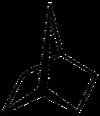Formula C7H8 Density 982 kg/m³ | Molar mass 92.14 g/mol Boiling point 108 °C | |
 | ||
What does quadricyclane mean
Quadricyclane is a strained, multi-cyclic hydrocarbon with potential uses as an additive for rocket propellants as well in solar energy conversion. These uses are limited, however, by the molecule's decomposition at relatively low temperatures (less than 400 °C).
Contents
- What does quadricyclane mean
- How to pronounce quadricyclane
- Structure and properties
- Preparation
- Reactions
- References
How to pronounce quadricyclane
Structure and properties
Quadricyclane is a highly strained molecule (78.7 kcal/mol). Isomerization of quadricyclane proceeds slowly at low temperatures without the use of a catalyst. Because of quadricyclane’s strained structure and thermal stability, it has been studied extensively.
In the presence of a catalyst norbornadiene is converted into quadricyclane via ~300nm UV radiation . When converted back to norbornadiene via irradiation, quadryicyclane’s ring strain energy is liberated in the form of heat (ΔH = −89 kJ/mol). This reaction has been proposed to store solar energy. However, the absorption edge of light does not extend past 300 nm whereas most solar radiation has wavelengths longer than 400 nm. Quadricyclane’s relative stability and high energy content have also given rise to its use as a propellant additive or fuel. However, quadricyclane undergoes thermal decomposition at relatively low temperatures (less than 400 °C). This property limits its applications, as propulsion systems may operate at temperatures exceeding 500 °C.
Preparation
Quadricyclane is produced by the irradiation of norbornadiene (bicyclo[2.2.1]hepta-2,5-diene) in the presence of Michler's ketone or ethyl Michler's ketone. Other sensitizers, such as acetone, benzophenone, acetophenone, etc., may be used but with a lesser yield. The yield is higher for freshly distilled norbornadiene, but commercial reagents will suffice.
Reactions
Quadricyclane readily reacts with acetic acid to give a mixture of nortricyclyl acetate and exo-norbornyl acetate. Quadricyclane also reacts with many dienophiles to form 1:1 adducts.
